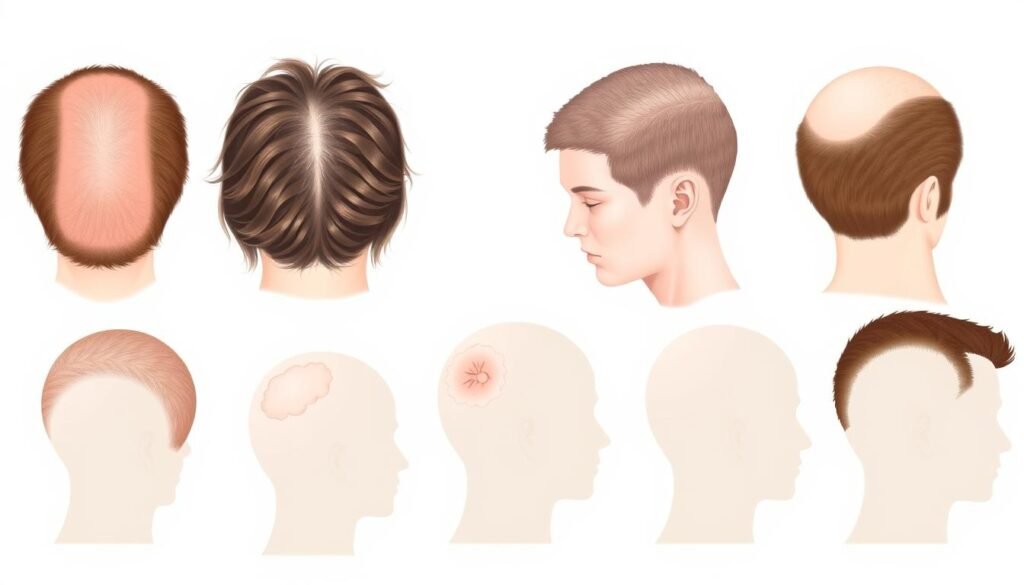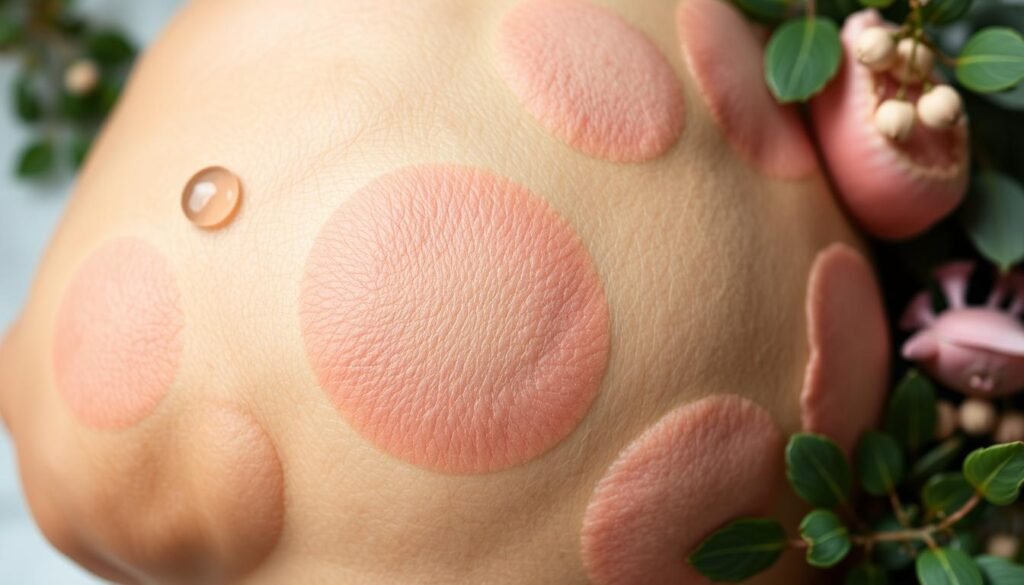Did you know around 50 million men and 30 million women in the United States face hair loss? This fact shows how common conditions like alopecia are, though many don’t understand them well. Spotting alopecia signs early can help find the right treatment.
Recognizing alopecia symptoms varies, as everyone has different hair loss patterns. This can include thinning hair, bald patches, or a receding hairline. It’s key for people worried about hair health to notice these signs.
Key Takeaways
- Hair loss affects millions, highlighting the importance of awareness.
- Identifying early signs can lead to timely treatments.
- Alopecia manifests in various symptoms and stages.
- Understanding individual hair loss patterns helps in recognizing alopecia.
- Seeking professional guidance is vital for accurate diagnosis.
Understanding Alopecia: What Is It?
Alopecia is a condition that leads to hair loss. It comes in different types. Alopecia definition includes various conditions that cause thin or no hair. This can happen anywhere on the body. Understanding alopecia means learning about its main types and what causes them.
Some types of alopecia are alopecia areata, which makes hair fall out in patches, and androgenetic alopecia. That’s the official term for the common issue of male or female pattern baldness. These types come from different causes like genetics, autoimmune diseases, or even the environment. Knowing these types is key to better manage hair loss.
Learning about alopecia is useful for anyone dealing with it. It helps people understand how to handle the loss of hair. They can find the best treatments and ways to cope with the situation.
Types of Alopecia and Their Characteristics
Alopecia includes different kinds, each with unique traits. It’s important to know these differences for correct care. Here are the main types of alopecia and their features.
Alopecia Areata
Alopecia areata is an autoimmune disease causing sudden, patchy hair loss. It can take you by surprise as it happens quickly. The tendency to get it might be inherited.
Androgenetic Alopecia
Often called male or female pattern baldness, androgenetic alopecia slowly thins your hair. Hormones and genes play a role here. It leads to a specific loss pattern in both sexes.
Scarring Alopecia
Scarring alopecia, a less common type, permanently destroys hair follicles. This results in lasting hair loss. Noticeable scalp changes like redness or itchiness may occur. Catching it early is key to prevent severe damage.
| Type of Alopecia | Characteristics | Common Symptoms |
|---|---|---|
| Alopecia Areata | Sudden hair loss in round patches | Hair loss in patches, possible regrowth |
| Androgenetic Alopecia | Gradual thinning of hair, pattern baldness | Thinning hairline, widening part |
| Scarring Alopecia | Permanent hair loss due to follicle damage | Redness, irritation, changes in scalp texture |
Spotting the Signs of Alopecia: Early Indicators
Spotting signs of alopecia early is key to get ahead of it. Being alert helps. Look out for changes in your hair’s health and how it looks.
Seeing your hair get thinner is a big early sign. It might mean you’re starting to lose hair. Finding more hair in your brush is another warning not to ignore.
When your hair feels weaker or looks different, it’s telling you something. These changes can mean there’s a problem with growing new hair.
- Thinning hair
- Increased hair shedding
- Changes in hair texture
- Uneven growth patterns
Notice these changes? It might be good to talk to a specialist. You can learn a lot about alopecia signs at this helpful site.
Keep an eye on how your hair changes over time. If you catch alopecia early, you might have better options for treatment.
Common Hair Loss Patterns to Look Out For
Recognizing early signs of hair loss is vital. Various patterns can point to certain types of alopecia. Spotting these early helps with timely action.
Thinning Hair
Thinning hair is a common pattern. It often starts slowly and is first seen at the crown or temples. If you notice less volume and your hair looks less full, pay attention. These signs could mean alopecia is beginning.
Bald Spots
Bald spots can suddenly show up and vary in size. They might be more noticeable in some people than others. Since they can mean different health issues, it’s important to look into them.
Uneven Hairline
An uneven hairline might mean the start of androgenetic alopecia. It’s when hair loss isn’t even or one side looks worse. Keeping an eye on your hairline changes is key. Early detection helps find the right treatment.

For deeper insights into hair loss, speaking with a healthcare expert is best. They can explain symptoms and ways to manage hair loss here.
| Hair Loss Pattern | Description | Additional Notes |
|---|---|---|
| Thinning Hair | Gradual loss of volume, noticeable at the crown and temples. | Early signs might hint at underlying alopecia. |
| Bald Spots | Sudden hair loss patches of various sizes. | Could point to specific alopecia types, needing attention. |
| Uneven Hairline | Asymmetrical receding hairline, often worse on one side. | Possible early indicator of androgenetic alopecia. |
The Role of Telogen Effluvium in Hair Loss
Telogen effluvium is a key reason for hair loss but it’s often temporary. It happens when too many hair follicles enter the resting phase. This change causes more hair to shed. Stress, physical shocks, changes in hormones, and after childbirth can trigger it.
It’s vital to know about temporary hair loss caused by telogen effluvium. It’s different from long-lasting hair loss types because it usually goes away by itself. When the cause is fixed, the hair often starts to grow back. Knowing the signs helps people tell it apart from permanent hair loss.
Things that can lead to telogen effluvium include:
- High stress levels
- Severe illness or surgery
- Pregnancy and childbirth
- Hormonal shifts, like thyroid problems
Understanding these causes is a big step towards handling the symptoms. It helps move forward to regaining normal hair growth.
Recognizing Symptoms Beyond Hair Loss
Alopecia means more than just losing hair. It’s important to know all the symptoms to understand when it’s time to see a doctor. Besides hair loss, you might feel itching or pain on your scalp. Your scalp might also look red.
Itching and Redness
If your scalp itches and looks red, it could mean inflammation. This is common with some types of alopecia. Spotting these signs early helps find the right treatment quickly.
Painful Sensations
Sometimes, your scalp might hurt or feel tender. This pain could point to another problem related to alopecia. Keeping an eye on these symptoms is key. It shows why getting checked by a doctor is so important.

The Importance of Trichology in Identifying Alopecia
Trichology is all about studying hair and scalp health. It’s essential for diagnosing hair problems like alopecia. Experts in this area use their knowledge to look into hair loss closely. They make treatment plans that fit each person’s unique situation.
Getting the diagnosis right is crucial for dealing with hair loss. Trichologists have tools like microscopes to tell alopecia types apart. This skill is vital for doctors to help patients better. Knowing exactly which alopecia type a person has helps in choosing the right treatment.
Seeing a trichologist is a smart move for anyone facing hair loss. They work with you to find the exact cause of your alopecia. Identifying alopecia at its source is key for good care. The insights from trichology lead to effective ways to manage hair loss.
In short, trichology plays a big role in dealing with alopecia. It helps us understand hair and scalp issues. This knowledge lets people choose treatments wisely, helping them feel better about themselves.
Consulting a Dermatologist: What to Expect
If you think you might have alopecia, seeing a consulting dermatologist is key. This expert will do a thorough dermatological evaluation. They start by looking into your medical past to find possible reasons for hair loss.
The next step is a scalp check. This lets the dermatologist see how your hair is losing out. They look for redness or irritation too. If needed, they might suggest a biopsy to pinpoint the alopecia type and plan the right treatment.
After checking everything, you’ll get advice tailored to you and talk about what treatments can do. Knowing all this helps you tackle hair loss head-on.

| Step | Description |
|---|---|
| Medical History Review | Discussion of past health issues and family history related to hair loss. |
| Scalp Examination | Visual assessment of scalp for patterns of hair loss and skin health. |
| Biopsy (if necessary) | Tissue sample taken from the scalp for further analysis of hair loss causes. |
| Treatment Discussion | Outline of potential treatment options based on evaluation findings. |
Treatment Options for Alopecia
Alopecia affects many people, leading to the search for effective treatments. There are different ways to treat it based on the type and severity. Each method aims to help hair grow back and enhance hair health.
Medications
Minoxidil and finasteride are often used to treat alopecia. Minoxidil works by stimulating the hair follicles. It’s something you can buy without a prescription. On the other hand, finasteride needs a doctor’s prescription. It stops certain hormones that cause hair loss. Talking to a healthcare provider can help choose the right treatment.
Therapies and Lifestyle Changes
Using natural treatments like essential oils or herbal supplements can also fight hair loss. Changing your lifestyle is important for your hair. These changes are crucial:
- Managing stress with mindfulness and exercise
- Eating a diet full of vitamins and minerals
- Drinking enough water to keep your scalp healthy
Such steps boost the effect of alopecia medicines. They also improve your mental and physical health. For more tips, check out Ageless Glimmer.
| Treatment Method | Type | Description |
|---|---|---|
| Minoxidil | Topical | Stimulates hair growth and prevents further hair loss. |
| Finasteride | Oral | Reduces hormonal factors leading to hair loss. |
| Essential Oils | Natural Therapy | Helps improve scalp health and promote hair growth. |
| Balanced Diet | Lifestyle Change | Nourishes hair follicles with essential nutrients. |
Emotional Impact of Alopecia and Coping Strategies
Alopecia can deeply affect a person’s feelings. It can cause worry, sadness, or lower self-confidence. Recognizing these emotions helps with mental health. Many gain comfort from support for hair loss in different ways.
Coping methods can bring comfort and a sense of control. Being part of support groups helps people connect. They can share what they’re going through with those who understand. Personal counseling offers more help by providing actionable tactics to deal with tough emotions.
Practicing self-affirmation is another way to cope. By telling ourselves positive things, we fight off negative thoughts. Finding groups, both in-person and online, offers additional support. It gives a feeling of community and understanding.
- Join support groups to share experiences.
- Consider therapy for emotional guidance.
- Practice self-affirmation to boost confidence.
- Engage in activities that promote relaxation.
Conclusion
It’s vital to know the signs of alopecia for early help and better care. Knowing what to look for helps people manage hair loss better. They can spot symptoms early, talk to experts, and find the right treatments.
Dealing with hair loss involves emotions too. Being aware helps folks handle changes and feel strong. With good info, people can tackle alopecia bravely, feeling good about themselves.
Staying alert and active improves life with alopecia. Getting advice from doctors or support from others is key. It’s crucial to recognize signs and understand alopecia for effective management.